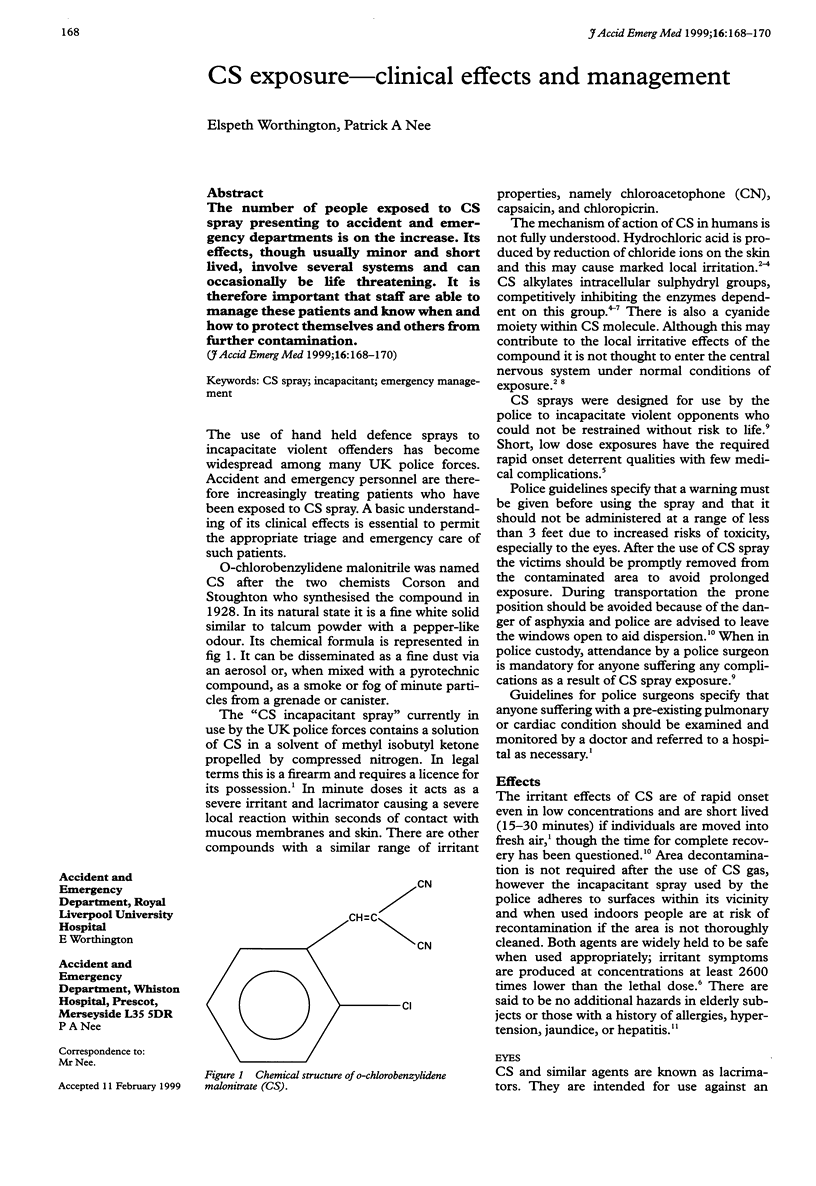Abstract
The number of people exposed to CS spray presenting to accident and emergency departments is on the increase. Its effects, though usually minor and short lived, involve several systems and can occasionally be life threatening. It is therefore important that staff are able to manage these patients and know when and how to protect themselves and others from further contamination.
Full text
PDF


Selected References
These references are in PubMed. This may not be the complete list of references from this article.
- Beswick F. W., Holland P., Kemp K. H. Acute effects of exposure to orthochlorobenzylidene malononitrile (CS) and the development of tolerance. Br J Ind Med. 1972 Jul;29(3):298–306. doi: 10.1136/oem.29.3.298. [DOI] [PMC free article] [PubMed] [Google Scholar]
- Bhattacharya S. T., Hayward A. W. CS gas--implications for the anaesthetist. Anaesthesia. 1993 Oct;48(10):896–897. doi: 10.1111/j.1365-2044.1993.tb07424.x. [DOI] [PubMed] [Google Scholar]
- Breakell A., Bodiwala G. G. CS gas exposure in a crowded night club: the consequences for an accident and emergency department. J Accid Emerg Med. 1998 Jan;15(1):56–57. doi: 10.1136/emj.15.1.56. [DOI] [PMC free article] [PubMed] [Google Scholar]
- Danto B. L. Medical problems and criteria regarding the use of tear gas by police. Am J Forensic Med Pathol. 1987 Dec;8(4):317–322. doi: 10.1097/00000433-198712000-00011. [DOI] [PubMed] [Google Scholar]
- Folb P. I., Talmud J. Tear gas--its toxicology and suggestions for management of its acute effects in man. S Afr Med J. 1989 Oct 7;76(7):295–295. [PubMed] [Google Scholar]
- Gray P. J., Murray V. Treating CS gas injuries to the eye. Exposure at close range is particularly dangerous. BMJ. 1995 Sep 30;311(7009):871–871. doi: 10.1136/bmj.311.7009.871. [DOI] [PMC free article] [PubMed] [Google Scholar]
- Holland P., White R. G. The cutaneous reactions produced by o-chlorobenzyl-idenemalononitrile and -chloroacetophenone when applied directly to the skin of human subjects. Br J Dermatol. 1972 Feb;86(2):150–154. doi: 10.1111/j.1365-2133.1972.tb16078.x. [DOI] [PubMed] [Google Scholar]
- Hu H., Christiani D. Reactive airways dysfunction after exposure to teargas. Lancet. 1992 Jun 20;339(8808):1535–1535. doi: 10.1016/0140-6736(92)91296-k. [DOI] [PubMed] [Google Scholar]
- Hu H., Fine J., Epstein P., Kelsey K., Reynolds P., Walker B. Tear gas--harassing agent or toxic chemical weapon? JAMA. 1989 Aug 4;262(5):660–663. doi: 10.1001/jama.262.5.660. [DOI] [PubMed] [Google Scholar]
- PUNTE C. L., OWENS E. J., GUTENTAG P. J. Exposures to orthochlorobenzylidene malononitrile. Controlled human exposures. Arch Environ Health. 1963 Mar;6:366–374. doi: 10.1080/00039896.1963.10663407. [DOI] [PubMed] [Google Scholar]
- Park S., Giammona S. T. Toxic effects of tear gas on an infant following prolonged exposure. Am J Dis Child. 1972 Mar;123(3):245–246. doi: 10.1001/archpedi.1972.02110090115018. [DOI] [PubMed] [Google Scholar]
- Ro Y. S., Lee C. W. Tear gas dermatitis. Allergic contact sensitization due to CS. Int J Dermatol. 1991 Aug;30(8):576–577. [PubMed] [Google Scholar]
- Vaca F. E., Myers J. H., Langdorf M. Delayed pulmonary edema and bronchospasm after accidental lacrimator exposure. Am J Emerg Med. 1996 Jul;14(4):402–405. doi: 10.1016/S0735-6757(96)90060-1. [DOI] [PubMed] [Google Scholar]
- Yih J. P. CS gas injury to the eye. BMJ. 1995 Jul 29;311(7000):276–276. doi: 10.1136/bmj.311.7000.276. [DOI] [PMC free article] [PubMed] [Google Scholar]


